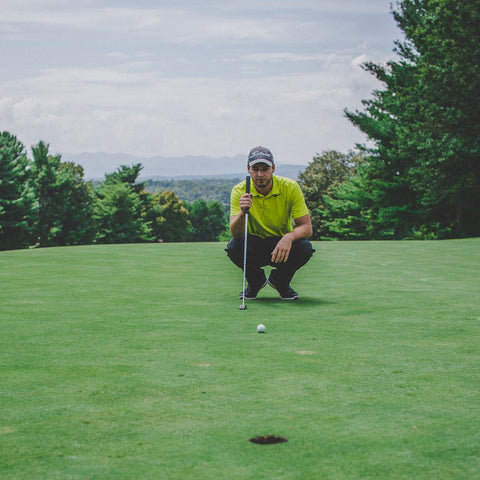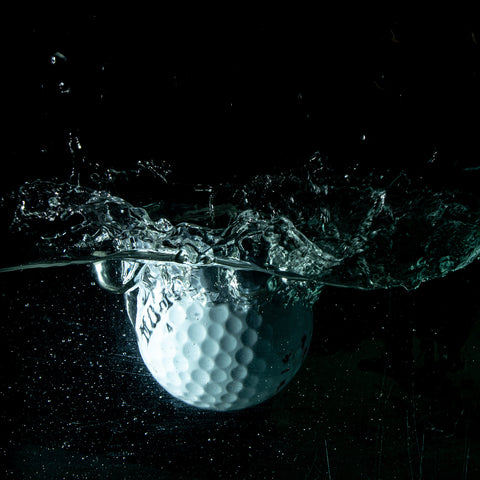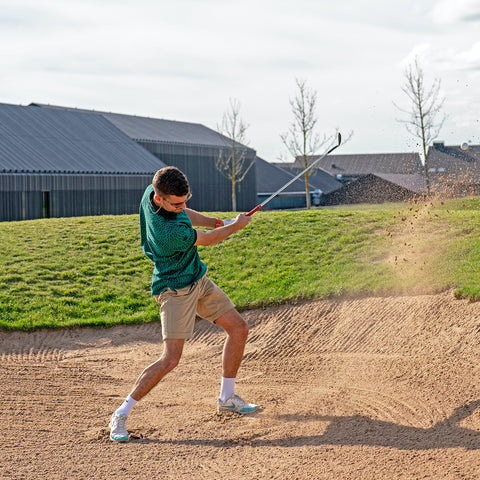Mastering the art of golf putting is a skill that can significantly improve your game. In this comprehensive guide we'll take you step-by-step through the process of refining your putting technique and making those crucial shots with confidence.
TOP TIP: For someone looking to improve their putting, the number one tip that can make a significant difference is consistency in your putting stroke. Developing a consistent and repeatable stroke is crucial because it directly affects your accuracy, control, and overall putting performance. When your putting stroke is consistent, you're more likely to make solid contact with the ball, resulting in better control over direction and distance. Here's how you can focus on improving the consistency of your putting stroke:
Step 1: Getting Positioned To Putt
Stance
Line up for your putt at a 90 degree angle. Get your legs hip width apart, with feet facing directly forwards. Don’t splay your feet!
Ball Position
The ball should now be positioned a little forward of the centre of your stance, and you should be making eye contact with it direct over the top or slight off centre. If you aren't able to, your putter may be too long!
Getting Your Putter Grip Right
There’s so many different grips out there, like reverse overlap, pencil, saw etc. we recommend each golfer do their research and find what works best for them. What’s important is that it’s a) comfortable for you and b) works to give a consistent motion and putt.
Step 2: Getting Aligned
Always have your feet and body parallel to the line you intend to putt. You can train with alignment rods (also called alignment sticks) to help get your angles spot on! Make sure your hips, knees and shoulders are all aligned too! A putt is all about control, so you don’t want to swing your hips into it like you would on a driver.
The club face should also be parallel to the putting line as well. When you go to look down your eyes should be right above or just off the top of the ball. If you’re struggling to do this, your putter may be too long! It might be worthwhile to call in to your local shop and get a sizing done.
Step 3: Reading Greens Like a Pro
Observing the Green
Take in all angles once you have the lay of your ball. Squat behind your ball, and also take a look from directly behind the hole in line with your ball. Is it uphill? May need a little more power. Does it slant to the left? Be aware the shot will naturally pull to that side and gain speed in that direction.
Pacing Your Putts
Gauge the speed of the green and adjust your approach to achieve the optimal pace for each putt. You'll need to consider, along with the topographical element, the weather. Is the grass wet and you’re out in a gale force wind? Or is it bone dry from a long hot summer? Even specific course design can vary, and it’s worth asking the seasoned local veterans of the course for their opinion before going to tee off.
Step 4: Mastering Your Putting Stroke
Consistency In Your Putting Motion
Like we mentioned above, a consistent and technically good positioning and swing will improve your control and make you a putting machine.
The Putting Swing Triangle
The motion should all be in your shoulders, down your arms to the club, or the triangle as it’s known. Your motion should rock back and forth like a clock pendulum, smooth and consistent in its range and motion.
Putter Impact Zone
You want to be hitting the centre of the putter face, straight on and flat. It’s important to keep the club face clean to ensure optimal impact.
Follow-Through
You want to follow through your putt with the same speed as your backswing and swing, roughly as far past your front leg as your backswing went past your back leg. A nice smooth speed and motion through the whole of the backswing, swing and floor through will give better putting results. Pulling up the shot early can result in bad impact, shanked shots and a lot of frustration!
Step 5: Elevate Skills through Purposeful Practice
Distance Control Drills
Hone your distance judgement through purposeful drills designed to refine your putting strength from varying lengths. Try the four ball drill: four balls in a row on a flat surface, try to hit each one with a consistent power and direction - don't peek after the first shot! Ramp up your swing each time. Compare your results at the end to see how consistent your swing has been - the balls should be in a diagonal to reflect the controlled increase in swing, if one is out of line, that means there's a weakness in technique, whether its too much power or inaccuracy on a shot. Practice makes perfect!
Putting Mats
A putting mat can be a great addition to the home, getting lots of extra reps in to work on your swing, length and speed. There’s even models with elevations and a varying surface to simulate a real course!
The Gate Drill
Enhance accuracy by guiding putts through a designated gate, refining your aim and alignment. The great thing is you can set up multiple gates at one time and practice away with a basket of golf balls, getting quick and effective practice in for improvement in accuracy.
Clock Drill Mastery
Polish your putt precision at different lengths by envisioning the hole as a clock's centre and putting from various "hour" positions. You will get good practice in different grass situations very quickly, helping you get used to changing your strategy dependent on the conditions.
Step 6: It’s All In Your Head: Nurturing a Strong Mental Game for Confident Putting
Focus on Focus
Many golfers have a routine or ritual to get in the zone with shots, similar to a tennis player before they serve. Get comfortable, decide on your line and then focus on your mechanics.
Routine for Results
Develop a consistent pre-putt routine that channels your focus, preparing you for poised and confident putts. Try mindfulness techniques, controlled breathing and visualisation to bring a level of zen to your swing and sink those shots.
Embark on your journey to putting mastery with patience and determination. For personalised guidance, consider the expertise of a golf instructor. By following these steps and embracing deliberate practice, you'll be well on your way to becoming a putting maestro on the golf course. Embrace the challenge and enjoy the rewards of perfecting your putting game!
FAQ
How do beginners practice putting?
Beginners can practice putting by following these steps:
- Start with short putts to build confidence.
- Focus on developing a consistent rhythm and tempo.
- Practice distance control by gradually increasing putt length.
- Use alignment aids to improve accuracy.
- Practice regularly to develop muscle memory and confidence.
Should you hit or stroke the putt?
When putting, it's better to focus on a smooth putting stroke rather than hitting the ball. A controlled, rhythmic stroke helps with distance and accuracy.
What is the proper putting stroke?
The proper putting stroke involves a pendulum-like motion with minimal wrist movement. Use your shoulders and arms to create a smooth, back-and-forth stroke to promote consistency and accuracy.
How should you set up for a putt?
Set up for a putt by:
- Positioning the ball slightly forward in your stance.
- Aligning your feet parallel to the target line.
- Gripping the putter comfortably with both hands.
- Bending slightly at the hips and maintaining a relaxed posture.
Where should I look when I putt?
When putting, focus your gaze on the target or the spot where you want the ball to roll. Avoid looking at the putter head or the ball during the stroke.
Where should I look at the ball when putting?
While addressing the ball, your eyes should be directly over the ball or slightly inside the target line. This helps you line up accurately and promotes a more consistent stroke.
Should arms be straight when putting?
While putting, it's not necessary to have completely straight arms. A slight bend in your elbows can help maintain a relaxed and natural putting motion. Avoid excessive tension in your arms.
Should your hips move when you putt?
Your hips should stay relatively still during the putting stroke. Minimize any unnecessary movement to maintain stability and consistency in your putting motion.
Why is mastering putting important for improving my golf game?
Mastering golf putting is essential because it can significantly enhance your overall game. A successful putting technique ensures accuracy, control, and consistency, directly impacting your scores on the course.
How does proper alignment contribute to accurate putting?
Proper alignment ensures that your putter face is perpendicular to your target line. This alignment minimises errors and greatly enhances your chances of hitting accurate putts.Can reading the green really make a difference in my putting performance?
Absolutely. Reading the green allows you to understand the slopes, breaks, and speed of the surface. This knowledge helps you adjust your putting strategy, resulting in more successful putts.
What's the significance of a consistent pre-putt routine?
A consistent pre-putt routine helps you establish focus, calm nerves, and prepare mentally for each putt. It contributes to a poised and confident stroke, ultimately improving your putting accuracy.
How can I select the right putter for my putting style?
Choosing the right putter involves considering factors such as the type of stroke you have (e.g., straight-back, straight-through, arcing), the weight and balance that feels comfortable, and any alignment aids that suit your preferences.
Can I use alignment aids to enhance my putting accuracy?
Yes, putters with built-in alignment guides can help you align the putter face accurately to your intended target line, increasing your chances of making successful putts.
How often should I practise my putting skills?
Regular practice is key to improvement. Consider dedicating time to practise your putting technique and drills at least a few times a week to build muscle memory and consistency.
Can I clean my putter to improve its performance?
Yes, keeping your putter clean and free from dirt or debris can improve its performance. A clean putter face ensures better contact with the ball, leading to more accurate putts. We also recommend keeping golf balls clean too.
Are there any effective ways to improve distance control in my putting?
Engage in distance control drills, like the clock drill mentioned in the guide, to refine your feel for various putt lengths. Practising these drills can improve your ability to judge distances accurately.
How do I maintain a strong mental game while under pressure?
Focus on your target, trust your routine, and practise mindfulness techniques to manage pressure. Consistent mental preparation can help you stay composed and confident during crucial putts.
Remember, continuous learning, practice, and refining your putting skills will lead to better performance and enjoyment on the golf course. Embrace the journey of improvement and celebrate your successes along the way. Happy putting!



